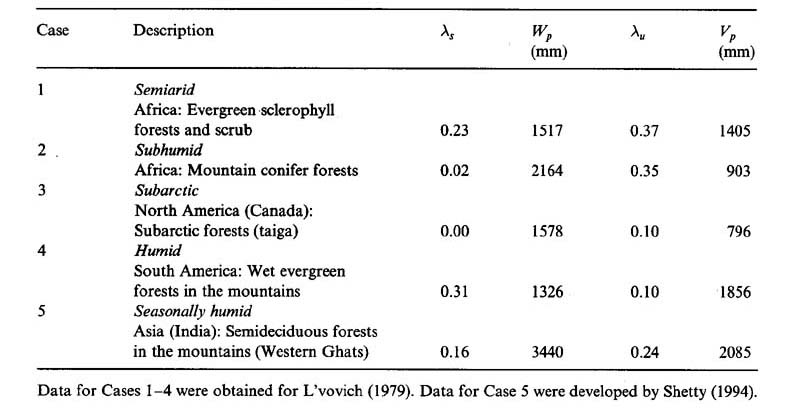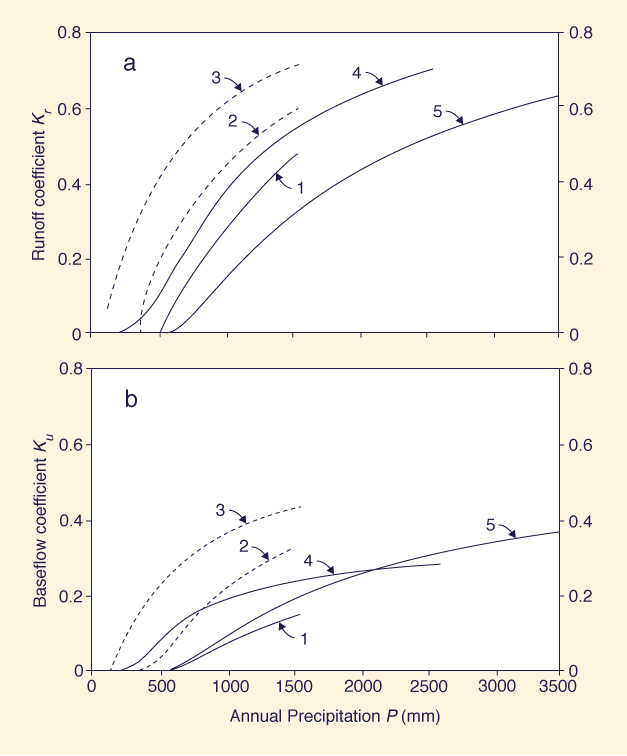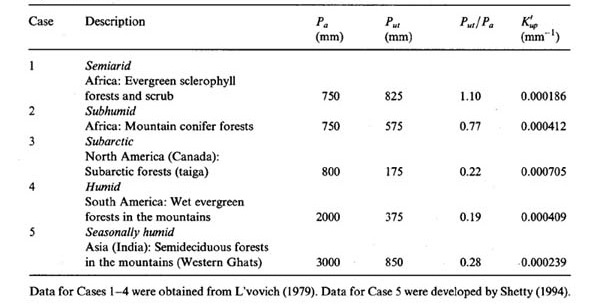1. INTRODUCTION The companion paper (Ponce and Shetty, 1995) has described a conceptual model of water balance which separates annual precipitation into surface runoff and wetting, and wetting into baseflow and vaporization, following concepts suggested by L'vovich (1979). The objective is to determine the fraction of annual precipitation which goes into surface runoff and the fraction of wetting which goes into baseflow. Runoff, or streamflow, consists of surface runoff and baseflow. A competition exists between surface runoff and wetting. Any drop of water that goes into surface runoff is a drop that does not add to catchment wetting. Similarly, a competition exists between baseflow and vaporization. Any drop of water that goes into baseflow is a drop that does not leave the catchment through vaporization.
Conflicting evidence regarding this dual competition is scattered throughout the literature. On a global basis, differences in biogeographical regions and climatic settings have tended to mask the nature of the competition. In this paper we simulate runoff and baseflow using a conceptual model of water balance described in the companion paper (Ponce and Shetty, 1995). The conceptual basis of the model enhances its applicability to a wide range of biogeographical regions and climatic settings. In this paper, selected catchment data for Africa, North America, and South America (L'vovich, 1979) are supplemented with the writers' own Asian data. Two runoff and baseflow functions are derived: (1) runoff and baseflow coefficients vs annual precipitation; (2) runoff and baseflow gains vs annual precipitation. Analysis of these functions leads to a characterization of runoff and baseflow throughout the climatic spectrum, shedding additional light on the competition between runoff and vaporization, and baseflow and vaporization. 2. THE CONCEPTUAL MODEL Annual precipitation P can be separated into two components (Ponce and Shetty, 1995):
in which S is surface runoff and W is wetting. In turn, wetting is separated into two components:
in which U is baseflow, and V is vaporization. As used here, the term "vaporization" encompasses all moisture returned to the atmosphere by evaporation: evapotranspiration from vegetated areas, evaporation from nonvegetated areas, and evaporation from water bodies. Runoff consists of surface runoff and baseflow:
Combining Eqs. (1)-(3) yields
The runoff coefficient is:
The vaporization coefficient is:
Runoff gain is defined herein as:
Vaporization loss is the derivate of the vaporization coefficient, or also:
The baseflow coefficient is (L' vovich, 1979):
Baseflow gain is defined herein as:
The sequential separation of annual precipitation into surface runoff and wetting, and wetting into baseflow and vaporization, is modeled by a proportional relation such that wetting asymptotically reaches an upper bound as precipitation and surface runoff increase unbounded. Likewise, vaporization asymptotically reaches an upper bound as wetting and baseflow increase unbounded. The surface runoff and baseflow submodels are given as Eqs. (16) and (18) of the companion paper (Ponce and Shetty, 1995), respectively.
Given a set of model parameters λs, Wp, λu and Vp,
the conceptual model separates annual precipitation into surface runoff and wetting, and wetting into baseflow and vaporization.
3. MODEL APPLICATION
Table 1 shows calibrated model parameters for five cases. The first four cases were included in the companion
paper Ponce and Shetty, 1995). In this contribution, we add a fifth case:
Figure 1 shows runoff and baseflow coefficients for the five cases included in this study. Analysis of this figure leads to the following conclusions:
Figure 2 shows runoff and baseflow gains for the five cases included in this study. Analysis of this figure leads to the following conclusions:
Table 2 shows mean annual precipitation, runoff threshold precipitation, ratio of runoff threshold precipitation to mean annual precipitation, and peak runoff gain for the five cases included in this study. Analysis of this table leads to the following conclusions:
Table 3 shows mean annual precipitation, baseflow threshold precipitation, ratio of baseflow threshold precipitation to mean annual precipitation, and peak baseflow gain for the five cases included in this study. Analysis of this table leads to the following conclusions:
4. COMPETITION BETWEEN RUNOFF AND VAPORIZATION, AND BASEFLOW AND VAPORIZATION Analysis of the runoff gain function serves to clarify the nature of the competition between runoff and vaporization. Two scenarios are possible, depending on the magnitude of annual precipitation relative to runoff threshold precipitation (Prt ): (1) for P < Prt , increases in annual precipitation lead to increases in runoff gain and proportionally larger increases in runoff; (2) for P > Prt , increases in annual precipitation lead to decreases in runoff gain and proportionally smaller increases in runoff.
For semiarid regions Prt ∕Pa ≈ 1. Therefore:
(1) P < Prt implies that
Unlike semiarid regions, for seasonally humid, humid, and subarctic regions Prt
∕ Pa < 0.3. Therefore: (1) P < Prt implies that
P < 0.3 Pa , and (2) P > Prt implies that P > 0.30 Pa . We conclude that vaporization is a strong competitor over runoff in humid regions (including seasonally
humid and subarctic) when the annual precipitation is above 0.3 Pa . That is, in a humid
region, a drop of rain is more likely to go to vaporization throughout a wide range of variation of
annual rainfall
The competition between baseflow and vaporization follows a pattern similar to that of runoff and vaporization.
5. SUMMARY
A conceptual model of water balance is used to simulate changes in runoff and baseflow with annual precipitation.
The model in based on the sequential separation of annual precipitation into surface runoff and wetting, and wetting
into basefiow and vaporization. The separation is modeled by a proportional relation such that wetting reaches
asymptotically an upper bound as precipitation and surface runoff increase unbounded. Likewise, vaporization
reaches asymptotically an upper bound as wetting and baseflow increase unbounded. The model parameters are
the initial abstraction coefficient for surface runoff λs , the wetting potential
Wp , the initial abstraction coefficient for baseflow
λu , and the vaporization potential Vp .
Runoff gain is defined as the derivative of runoff coefficient with respect to precipitation. Baseflow gain is defined as the derivative of baseflow coefficient with respect to precipitation. Catchment data show that baseflow gains are always positive. Runoff gain reaches a peak for a runoff threshold precipitation; baseflow gain reaches a peak for a baseflow threshold precipitation.
Two runoff and baseflow functions are derived: (1) runoff and baseflow coefficients vs annual precipitation; (2) runoff and
baseflow gains vs annual precipitation. The ratio of threshold precipitation Pt to mean annual
precipitation Pa is shown to characterize the climatic setting, as follows: in
semiarid regions, Pt ∕Pa is high, with values close to
unity; in subhumid regions,Pt ∕Pa has midrange values, less
than unity; in seasonally humid, humid, and subarctic regions,
Analysis of runoff and baseflow functions sheds additional light on the nature of the competition between runoff and vaporization, and baseflow and vaporization.
Runoff and baseflow are shown to be strong competitors over vaporization in the case of greatest practical interes, i.e., in semiarid regions when the annual precipitation is below average (P < Pa ). On the other hand, vaporization is shown to be strong competitor over runoff and baseflow in humid regions throughout a wide range of variation of annual rainfall (P > 0.3 Pa).
ACKNOWLEDGMENTS
The present study was performed in Spring 1994, while A.V. Shetty was at San Diego State University, on leave from the Hard Rock Regional Centre, National Institute of Hydrology, Belgaum, Karnataka, India. His leave was funded by the United Nations Development Programme.
REFERENCES
Baker, Jr., M. B. 1986. Effects of Ponderosa pine treatment on water yield in Arizona. Water Resour. Res., 22(1): 63-67.
Bosch, J. M. and J. D. Hewlett. 1982. A review of catchment experiments to determine the effect of vegetation changes on water yield and evapotranspiration. J. Hydrol., 55: 3-23.
Hibbert, A. R. 1967. Forest treatment effects on water yield. In: W.E. Sopper and H.W. Lull (Editors), International Symposium on Forest Hydrology. Pergarnon, Oxford.
L'vovich, M. I. 1979. World water resources and their future. Original in Russian. English translation, American Geophysical Union, Washington, DC.
Pitman, W. V. 1978. Trends in streamflow due to upstream land use changes. J. Hydrol., 39:227-237. .
Ponce, V. M. and A. V. Shetty. 1995. A conceptual model of catchment water balance: 1.
Formulation and calibration. J. Hydrol., 173: 27-40.
Ruprecht, J. K. and N. J. Schofield. 1989. Analysis of streamflow generation following deforestation in southwest Western Australia. J. Hydrol., 105: 1-17
Ruprecht, J. K. and G. L. Stoneman. 1993. Water yield issues in
the jarrah forest of southwestern Australia. J. Hydrol., 150: 369-391.
Shetty. A. V. 1994. Application of water balance conceptual model to the Malaprabha river basin, Karnataka.
National Institute of Hydrology Report, Roorkee, Roorkee, Uttar Pradesh, India.
|
| 211229 |
| Documents in Portable Document Format (PDF) require Adobe Acrobat Reader 5.0 or higher to view; download Adobe Acrobat Reader. |





